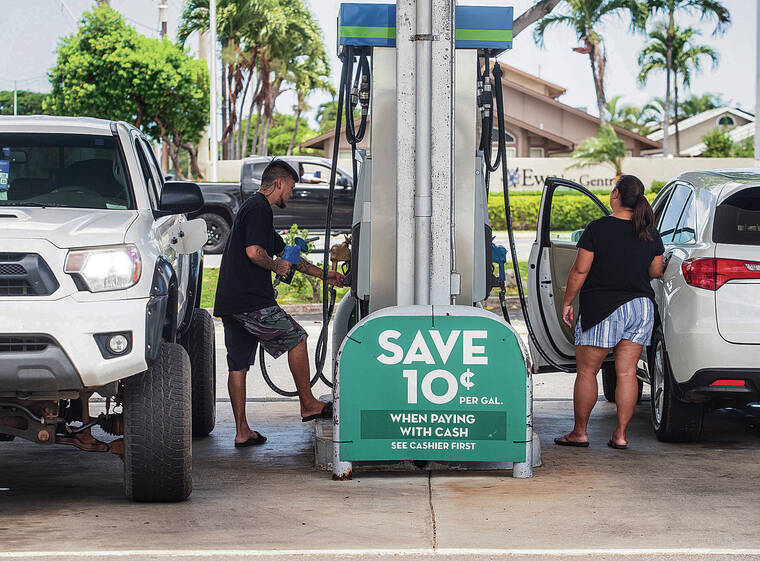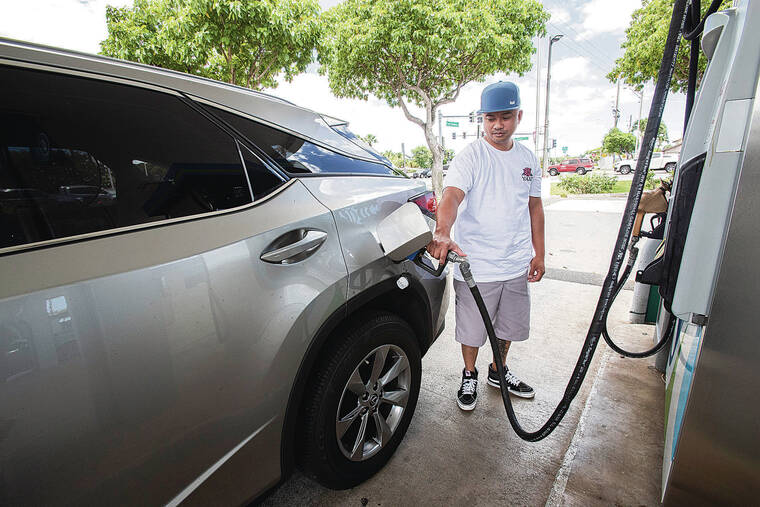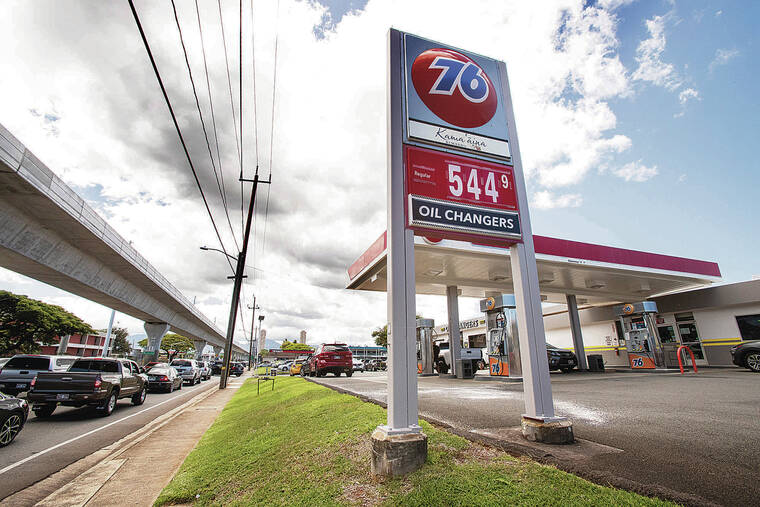Jeffrey Krantz has a gas-tank-half-full view of the continuing rise in Hawaii gas prices.
For one, he doesn’t have to drive 100 miles to work like some people on the mainland. Secondly, Hawaii’s average gas price — $5.46 per gallon Friday for regular — is second-highest in the nation behind California, where the average was $6.25, according to AAA.
“Of course it’s always nice to have less fuel cost,” said Krantz, a local boat captain who feels worse for relatives in San Diego who are paying $7.50 a gallon. “In that respect, we’re fortunate.”
Still, it can be painful to watch a digital gas pump meter rise, and rise, and rise when filling up.
Sarah Ramia, a teacher on Oahu, paid $86.49 to fill her small BMW sport utility vehicle Friday with about 14.6 gallons of premium grade gas priced at $5.92 a gallon.
“It is what it is,” she said, resigned to the cost, which has been elevated in large part because of global oil prices pushed up amid impacts from Russia’s war in Ukraine Opens in a new tab since February. “You have to get gas.”
Hawaii’s $5.46 average price for a gallon of regular gas is up 4% from $5.27 a month ago, and 39% from $3.94 a year ago.
For a midsize car with a 15-gallon tank, it would have cost $59.10 to fill up a year ago compared with $81.90 on Friday, based on the state average.
By major local metropolitan areas, Honolulu has the lowest average price at $5.35 per gallon, and Lihue has the highest at $5.85.
Hawaii has historically had the highest or near-highest gas price among U.S. states, in part because of limited competition among gas producers in a small market with higher transportation and other operating costs.
However, last week gas prices rose much more in other states than in Hawaii, due in large part to increased demand for gas as consumers prepared to travel for Memorial Day weekend.
AAA reported on Thursday that the biggest rise in average gas prices among states from a week earlier was a 33-cent jump in Indiana. Nine other states had increases from 18 cents to 31 cents. Hawaii’s average was up 2 cents.
The organization cited U.S. Energy Information Administration data showing that gasoline demand increased by 8.8 million barrels a day during the week prior to the three-day Memorial Day weekend, while domestic gasoline stocks decreased by 770,000 barrels to 291 million barrels in the same period.
“These supply and demand dynamics have contributed to rising pump prices,” AAA said. “Coupled with volatile crude oil prices, pump prices will likely remain elevated as long as demand grows and supply remains tight.”
AAA noted that prices for crude oil, used to make gas, have increased amid supply concerns from the market as the European Union works to implement a 90% ban on Russian oil imports by the end of this year, as well as from increased market demand expectations after China lifted COVID-19 restrictions in Shanghai.
Hawaii used to rely quite substantially on oil from Russia until shortly before President Joe Biden banned imports from that country in March.
In recent years before the ban, Hawaii was receiving 20% to 25% of its crude from Russia, compared with about 3% for the United States.
Par Hawaii, the only oil refinery in the state, suspended purchases of Russia crude just ahead of the ban and is now relying on other sources, principally in North and South America, to meet Hawaii’s needs.
Eric Wright, Par Hawaii president, said in a statement that crude oil prices worldwide have jumped 50% since January.
“This naturally has affected the cost of refined products, and this is reflected in prices at the pump at retail stations,” he said.
Wright added that it’s difficult to predict what may happen with prices in the short term, given factors that include Europe’s move to curtail oil imports from Russia and plans by the multicountry oil production organization OPEC and other allied producing countries to increase production.
“We are monitoring how supply and demand will have an impact on crude oil prices,” he said.
Claudia Rapkoch, public information officer for the State Energy Office, also said that it’s hard to tell when Hawaii consumers and businesses could see a return to lower gas prices given the uncertainty in global oil markets.
“The price we pay for oil — and everything that is created from it like gasoline, jet fuel, low-sulfur fuel oil, naphtha, etc. — depends on global markets and the many forces that are at play within it,” she said in a statement. “Right now, it is impossible to say with certainty what relief may be found or when.”
Rapkoch added that the most effective short-term defense against rising energy costs is conservation and efficiency.
“This includes walking, biking, public-transportation, car-pooling, working from home, and other measures,” she said. “The long-term solution is to be found through eliminating our reliance on fossil-fuel and continuing the transition to locally produced renewable energy.”
—
On the rise
Average price per gallon of regular gas in Hawaii
>> Friday: $5.46
>> Week earlier: $5.43
>> Month earlier: $5.27
>> Year earlier: $3.94
Average gas prices for regular unleaded as of Friday
>> National: $4.76
>> Hawaii: $5.46
>> Honolulu: $5.35
>> Hilo: $5.49
>> Kahului: $5.58
>> Lihue: $5.85
Source: gasprices.aaa.com






